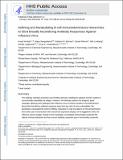| dc.contributor.author | Amitai, Assaf | |
| dc.contributor.author | Sangesland, Maya | |
| dc.contributor.author | Barnes, Ralston M | |
| dc.contributor.author | Rohrer, Daniel | |
| dc.contributor.author | Lonberg, Nils | |
| dc.contributor.author | Lingwood, Daniel | |
| dc.contributor.author | Chakraborty, Arup K | |
| dc.date.accessioned | 2022-02-10T23:09:51Z | |
| dc.date.available | 2022-01-04T19:22:55Z | |
| dc.date.available | 2022-02-10T23:09:51Z | |
| dc.date.issued | 2020-10 | |
| dc.date.submitted | 2020-08 | |
| dc.identifier.issn | 2405-4720 | |
| dc.identifier.issn | 2405-4712 | |
| dc.identifier.uri | https://hdl.handle.net/1721.1/138807.2 | |
| dc.description.abstract | © 2020 Elsevier Inc. The antibody repertoire possesses near-limitless diversity, enabling the adaptive immune system to accommodate essentially any antigen. However, this diversity explores the antigenic space unequally, allowing some pathogens like influenza virus to impose complex immunodominance hierarchies that distract antibody responses away from key sites of virus vulnerability. We developed a computational model of affinity maturation to map the patterns of immunodominance that evolve upon immunization with natural and engineered displays of hemagglutinin (HA), the influenza vaccine antigen. Based on this knowledge, we designed immunization protocols that subvert immune distraction and focus serum antibody responses upon a functionally conserved, but immunologically recessive, target of human broadly neutralizing antibodies. We tested in silico predictions by vaccinating transgenic mice in which antibody diversity was humanized to mirror clinically relevant humoral output. Collectively, our results demonstrate that complex patterns in antibody immunogenicity can be rationally defined and then manipulated to elicit engineered immunity. | en_US |
| dc.language.iso | en | |
| dc.publisher | Elsevier BV | en_US |
| dc.relation.isversionof | http://dx.doi.org/10.1016/J.CELS.2020.09.005 | en_US |
| dc.rights | Creative Commons Attribution-NonCommercial-NoDerivs License | en_US |
| dc.rights.uri | http://creativecommons.org/licenses/by-nc-nd/4.0/ | en_US |
| dc.source | PMC | en_US |
| dc.title | Defining and Manipulating B Cell Immunodominance Hierarchies to Elicit Broadly Neutralizing Antibody Responses against Influenza Virus | en_US |
| dc.type | Article | en_US |
| dc.identifier.citation | Amitai, Assaf, Sangesland, Maya, Barnes, Ralston M, Rohrer, Daniel, Lonberg, Nils et al. 2020. "Defining and Manipulating B Cell Immunodominance Hierarchies to Elicit Broadly Neutralizing Antibody Responses against Influenza Virus." Cell Systems, 11 (6). | en_US |
| dc.contributor.department | Massachusetts Institute of Technology. Department of Chemical Engineering | |
| dc.contributor.department | Ragon Institute of MGH, MIT and Harvard | |
| dc.contributor.department | Massachusetts Institute of Technology. Department of Physics | |
| dc.contributor.department | Massachusetts Institute of Technology. Department of Biological Engineering | |
| dc.contributor.department | Massachusetts Institute of Technology. Department of Chemistry | |
| dc.contributor.department | Massachusetts Institute of Technology. Institute for Medical Engineering & Science | |
| dc.relation.journal | Cell Systems | en_US |
| dc.eprint.version | Author's final manuscript | en_US |
| dc.type.uri | http://purl.org/eprint/type/JournalArticle | en_US |
| eprint.status | http://purl.org/eprint/status/PeerReviewed | en_US |
| dc.date.updated | 2022-01-04T19:19:04Z | |
| dspace.orderedauthors | Amitai, A; Sangesland, M; Barnes, RM; Rohrer, D; Lonberg, N; Lingwood, D; Chakraborty, AK | en_US |
| dspace.date.submission | 2022-01-04T19:19:06Z | |
| mit.journal.volume | 11 | en_US |
| mit.journal.issue | 6 | en_US |
| mit.license | PUBLISHER_CC | |
| mit.metadata.status | Authority Work Needed | en_US |
